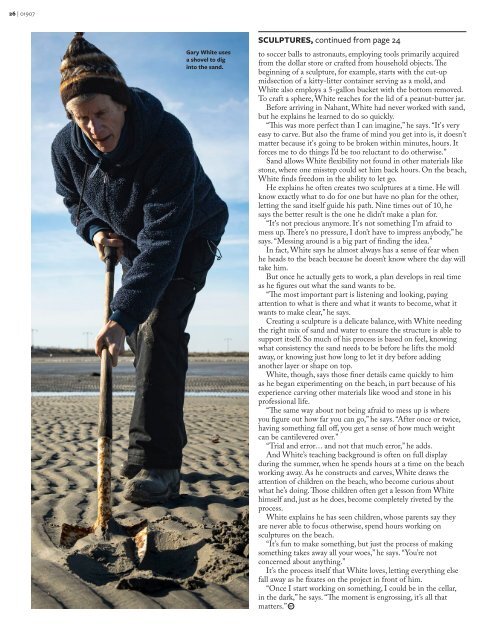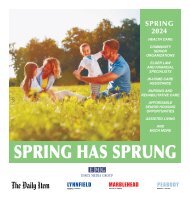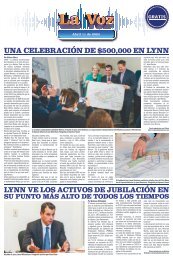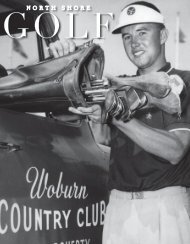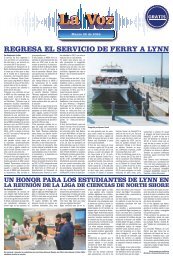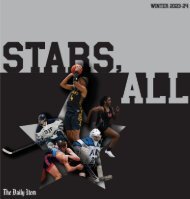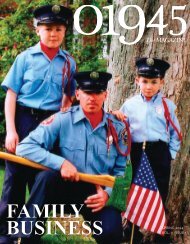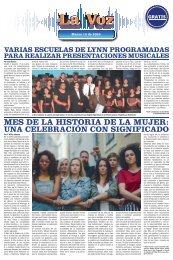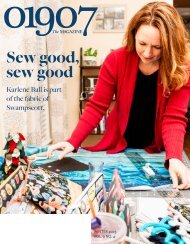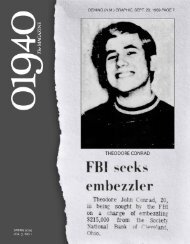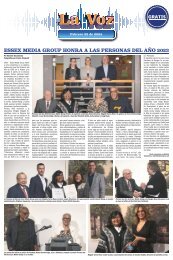01907 Spring 2024
You also want an ePaper? Increase the reach of your titles
YUMPU automatically turns print PDFs into web optimized ePapers that Google loves.
26 | <strong>01907</strong><br />
Gary White uses<br />
a shovel to dig<br />
into the sand.<br />
SCULPTURES, continued from page 24<br />
to soccer balls to astronauts, employing tools primarily acquired<br />
from the dollar store or crafted from household objects. The<br />
beginning of a sculpture, for example, starts with the cut-up<br />
midsection of a kitty-litter container serving as a mold, and<br />
White also employs a 5-gallon bucket with the bottom removed.<br />
To craft a sphere, White reaches for the lid of a peanut-butter jar.<br />
Before arriving in Nahant, White had never worked with sand,<br />
but he explains he learned to do so quickly.<br />
“This was more perfect than I can imagine,” he says. “It's very<br />
easy to carve. But also the frame of mind you get into is, it doesn't<br />
matter because it's going to be broken within minutes, hours. It<br />
forces me to do things I’d be too reluctant to do otherwise.”<br />
Sand allows White flexibility not found in other materials like<br />
stone, where one misstep could set him back hours. On the beach,<br />
White finds freedom in the ability to let go.<br />
He explains he often creates two sculptures at a time. He will<br />
know exactly what to do for one but have no plan for the other,<br />
letting the sand itself guide his path. Nine times out of 10, he<br />
says the better result is the one he didn’t make a plan for.<br />
“It's not precious anymore. It's not something I'm afraid to<br />
mess up. There’s no pressure, I don’t have to impress anybody,” he<br />
says. “Messing around is a big part of finding the idea.”<br />
In fact, White says he almost always has a sense of fear when<br />
he heads to the beach because he doesn’t know where the day will<br />
take him.<br />
But once he actually gets to work, a plan develops in real time<br />
as he figures out what the sand wants to be.<br />
“The most important part is listening and looking, paying<br />
attention to what is there and what it wants to become, what it<br />
wants to make clear,” he says.<br />
Creating a sculpture is a delicate balance, with White needing<br />
the right mix of sand and water to ensure the structure is able to<br />
support itself. So much of his process is based on feel, knowing<br />
what consistency the sand needs to be before he lifts the mold<br />
away, or knowing just how long to let it dry before adding<br />
another layer or shape on top.<br />
White, though, says those finer details came quickly to him<br />
as he began experimenting on the beach, in part because of his<br />
experience carving other materials like wood and stone in his<br />
professional life.<br />
“The same way about not being afraid to mess up is where<br />
you figure out how far you can go,” he says. “After once or twice,<br />
having something fall off, you get a sense of how much weight<br />
can be cantilevered over.”<br />
“Trial and error… and not that much error,” he adds.<br />
And White’s teaching background is often on full display<br />
during the summer, when he spends hours at a time on the beach<br />
working away. As he constructs and carves, White draws the<br />
attention of children on the beach, who become curious about<br />
what he’s doing. Those children often get a lesson from White<br />
himself and, just as he does, become completely riveted by the<br />
process.<br />
White explains he has seen children, whose parents say they<br />
are never able to focus otherwise, spend hours working on<br />
sculptures on the beach.<br />
“It’s fun to make something, but just the process of making<br />
something takes away all your woes,” he says. “You’re not<br />
concerned about anything.”<br />
It’s the process itself that White loves, letting everything else<br />
fall away as he fixates on the project in front of him.<br />
“Once I start working on something, I could be in the cellar,<br />
in the dark,” he says. “The moment is engrossing, it’s all that<br />
matters.”


